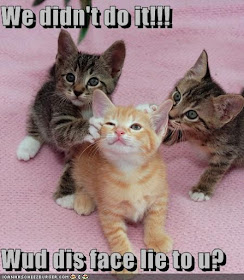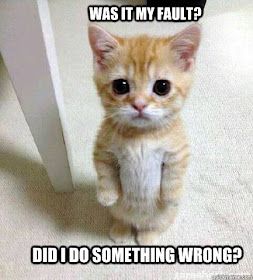It is only relatively recently that cats have shed their sinister
associations to become a much loved, benign pet and family member. In previous
centuries the cat was viewed with suspicion or even regarded as the Devil's
agent.
"Among quadrupeds the
cat has long been looked upon with suspicion, a circumstance due no doubt to
the belief that this was one of the forms in which witches were wont to
masquerade."
Corrie 1890/1
This goes some way to
explain why there are so many superstitions linking cats and death. Indeed our
first custom relates to cat predicting death.
It was said if a cat refused to come into the house where a sick person lay, this was a predictor of the latter's impending departure from this earth. This ability was said to be due to the cat's ability to see beyond the physical world and tap into the supernatural.
It was said if a cat refused to come into the house where a sick person lay, this was a predictor of the latter's impending departure from this earth. This ability was said to be due to the cat's ability to see beyond the physical world and tap into the supernatural.
"Mrs Fawset's cat had
been curled asleep on the rug...he started up, eyes glaring, fur on end and
made fantic efforts to get out of the room...We later learnt this was the exact
time that Mrs Fawset died."
22 Nov 1930
Conversely, in previous
centuries if a member of the household died, the cat was banned from the
house. This stems from a belief that if the cat jumped over the body or coffin,
the welfare of the deceased spirt would be imperiled.
"It was not uncommon
for the cat to be imprisoned beneath an inverted tub." Wood 1911
This fear even extended to
the funeral cortege, with widespread panic from the mourners if a cat was spotted strolling near
the church.
Turning things on their
head, the is a traditional saying: "Curiosity killed the cat."
Playwright Ben Jonson used a similar phrase in his 1598 play, Every Man in his
Humour.
"Helter skelter, hang sorrow, care will kill a cat, up-tails all, and a pox on the hangman."
Shakespeare used a similar version of this saying in Much Ado About Nothing (1599)
"What, courage man!
What though care killed a cat, though has mettle enough in thee to kill
care."
So when did curiosity put
in an appearance?
The earliest written
record of "Curiosity killed the cat" was in a compendium published in
1873, where it was listed an an Irish proverb, and it makes more sense to me
than "Care killed the cat."
***
New Release!
Castles, Customs, and Kings: True Tales by English Historical Fiction Authors, Volume 2
Edited by Debra Brown and Sue Millard
Castles, Customs, and Kings: True Tales by English Historical Fiction Authors, Volume 2
Edited by Debra Brown and Sue Millard
Contributing author: Grace Elliot
An anthology of essays from the second year of the English Historical Fiction Authors blog, this book transports the reader across the centuries from prehistoric to twentieth century Britain. Nearly fifty different authors share the stories, incidents, and insights discovered while doing research for their own historical novels.
From medieval law and literature to Tudor queens and courtiers, from Stuart royals and rebels to Regency soldiers and social calls, experience the panorama of Britain’s yesteryear. Explore the history behind the fiction, and discover the true tales surrounding Britain’s castles, customs, and kings.
Purchase links:
Amazon US
Amazon UK
An anthology of essays from the second year of the English Historical Fiction Authors blog, this book transports the reader across the centuries from prehistoric to twentieth century Britain. Nearly fifty different authors share the stories, incidents, and insights discovered while doing research for their own historical novels.
From medieval law and literature to Tudor queens and courtiers, from Stuart royals and rebels to Regency soldiers and social calls, experience the panorama of Britain’s yesteryear. Explore the history behind the fiction, and discover the true tales surrounding Britain’s castles, customs, and kings.
Purchase links:
Amazon US
Amazon UK

























